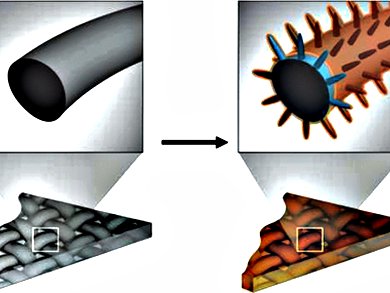Supercapacitors represent an important energy storage device, as they provide higher energy and power outputs, as well as better cycling stability compared to ordinary batteries. One type of supercapacitors are so-called pseudo-capacitors. Here the energy storage is based on very fast and reversible redox reactions on the surface of an electro-active material. Polyaniline (PAni) is one of the most promising materials for pseudo-capacitors but suffers from large volume changes during the redox-reaction due to repeated insertion and de-insertion of electrolyte ions, leading to poor mechanical stability and, hence, fast capacitance decay.
Husam N. Alshareef, King Abdullah University of Science and Technology, Thuwal, Saudi Arabia, and colleagues improved the cycling stability of PAni pseudo-capacitors by the construction of a PAni-RuO2 core-shell structure. Firstly, a PAni nanofiber array is created by a dilute chemical polymerization of aniline on a carbon fiber cloth. In a second step an ultrathin RuO2 layer is grown on the polymer by atomic layer disposition (ALD). This RuO2-layer not only effectively prevents damage on the PAni structure during charging and discharging but also facilitates the charge transfer and electrolyte ion diffusion to the PAni electrode.
- Highly Stable Supercapacitors with Conducting Polymer Core-Shell Electrodes for Energy Storage Applications,
Chuan Xia, Wei Chen, Xianbin Wang, Mohamed N. Hedhili, Nini Wei, Husam N. Alshareef,
Adv. Energy Mat. 2015.
DOI: 10.1002/aenm.201401805



